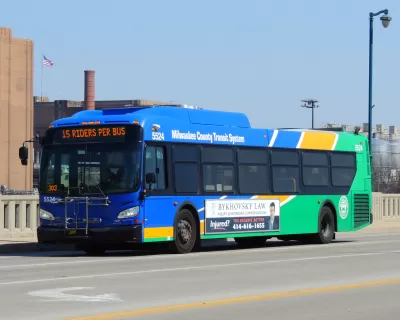The county’s transit system won’t pursue a second rapid bus line due to financial constraints.

A postponed bus rapid transit (BRT) project in Milwaukee could be shelved for a decade or more, says the Milwaukee County Transit System.
“The north-south project would have been called the Connect 2 and intersected with Connect 1, the nine-mile BRT line running between downtown Milwaukee and the Milwaukee Regional Medical Center in Wauwatosa,” explains Graham Kilmer in Urban Milwaukee.
“A major factor driving the decision, according to MCTS, was new estimates that it would cost approximately $6 million annually to operate the second BRT line.” The system will shift funds that would have gone to the project to its operating budget instead, buying the system one more year before having to consider service cuts. According to Kilmer, “MCTS will need action at the state level to secure enough revenue to stabilize the system and pursue a project like the Connect 2 again.”
FULL STORY: New BRT Project Gone For a Decade

Trump Administration Could Effectively End Housing Voucher Program
Federal officials are eyeing major cuts to the Section 8 program that helps millions of low-income households pay rent.

Planetizen Federal Action Tracker
A weekly monitor of how Trump’s orders and actions are impacting planners and planning in America.

Ken Jennings Launches Transit Web Series
The Jeopardy champ wants you to ride public transit.

Crime Continues to Drop on Philly, San Francisco Transit Systems
SEPTA and BART both saw significant declines in violent crime in the first quarter of 2025.

How South LA Green Spaces Power Community Health and Hope
Green spaces like South L.A. Wetlands Park are helping South Los Angeles residents promote healthy lifestyles, build community, and advocate for improvements that reflect local needs in historically underserved neighborhoods.

Sacramento Plans ‘Quick-Build’ Road Safety Projects
The city wants to accelerate small-scale safety improvements that use low-cost equipment to make an impact at dangerous intersections.
Urban Design for Planners 1: Software Tools
This six-course series explores essential urban design concepts using open source software and equips planners with the tools they need to participate fully in the urban design process.
Planning for Universal Design
Learn the tools for implementing Universal Design in planning regulations.
Heyer Gruel & Associates PA
Ada County Highway District
Institute for Housing and Urban Development Studies (IHS)
City of Grandview
Harvard GSD Executive Education
Toledo-Lucas County Plan Commissions
Salt Lake City
NYU Wagner Graduate School of Public Service





























